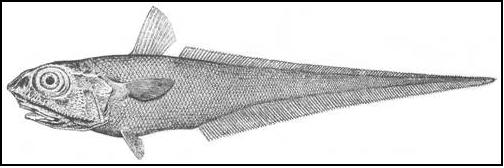Roughhead grenadier (Macrourus berglax) COSEWIC assessment and status report: chapter 3
Species Information
Name and classification
Macrourus berglax, Lacepede, 1801 is a member of the family Macrouridae (rattails), and is generally known as the roughhead grenadier. Synonyms are as follows: Coryphaena rupestris Fabricius, 1780; Macrourus rupestris Bloch, 1786; Macrurus fabricii Sundevall, 1842; Macrourus holotrachys Collett, 1896; Coryphaenoides berglax Collett, 1905. In Canada, it is commonly known as the roughhead grenadier, the onion eye, and smooth-spined rattail. The French refer to M. berglax as grenadier berglax and the Inuit, Ingminniset, meaning “it bellows when dying” (Leim & Scott 1966; Scott & Scott 1988; Cohen et al. 1973).
Description
The basic body and head shape of roughhead grenadiers are typical for the family Macrouridae (Bigelow & Schroeder 1953). They exhibit a large head and a moderately slender body, tapering uniformly to a pointed tail (Figure 1; Scott & Scott 1988).
Figure 1. Illustration of Macrourus berglax. Drawn by H.L.Todd and reproduced from Collette and Klein-MacPhee (2002) with permission from the Division of Fishes, National Museum of Natural History, Smithsonian Institution.

The roughhead grenadier can grow up to 1 metre in length (Bigelow & Schroeder 1953; Collette & Klein-MacPhee 2002). The body is ash-grey in color with a darker chest, anal fin, and hind edges of the posterior scales (Scott & Scott 1988; Cohen et al. 1990). Their heads are broad and comprise approximately 25% of the total body length. A small chin barbel is present, gillrakers are reduced, and there are three to five irregular rows of pointed teeth in the upper jaw (Whitehead et al. 1986; Scott & Scott 1988; Cohen et al. 1990).
The roughhead grenadier’s distinguishing features also provide it with its common name. This fish has a fairly broad head exhibiting ridges with scute-like scales bearing strong spinules (Scott & Scott 1988). They can be distinguished from other grenadiers in the North Atlantic by a prominent and pointed snout that is equal to eye height and is almost or completely scaleless underneath (Whitehead et al. 1986).
Designatable units
Recent studies suggest some genetic differentiation in roughhead grenadier at large geographic scales in the North Atlantic, with grenadiers in West Greenland, East Greenland and the Norwegian Sea comprising separate stock units (Katsarou & Naevdal 2001). However, in the waters off Canada, roughhead grenadier show a continuous distribution along the slope of the continental shelf from the Davis Strait to the southern Grand Bank (D.W. Kulka, unpublished analyses). They are also distributed between the Grand Bank and Flemish Cap in the area called the Flemish Pass. In the absence of any information to suggest local adaptation and genetic differentiation within this range, the working hypothesis for this report is that roughhead grenadier comprise a single designatable unit (DU) in the waters off Atlantic Canada (including the Flemish Cap and other waters beyond the 200-mile limit).